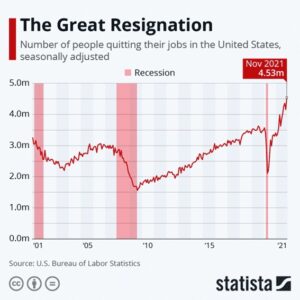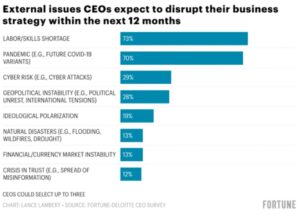A recent survey revealed that 55% of the workforce in the US have left their former jobs. Because of this, the term Great Resignation has become a part of our common language today. It is is currently impacting all aspects of peoples’ personal lives and business performances. And when so many workers leave a business, it particularly impacts customer service.

Even if job vacancies aren’t in customer facing roles, staffing shortages and turnover has a profound impact on your customers. A survey of customers of the quick service restaurant space found that:
- 72% noted there are not enough employees or staff
- 69% noted that employees are not paid enough
- 68% found that employees struggle with fulfilling both in-store and mobile orders
- 67% noted increased wait time
- 66% feel employees are not given sufficient training
Squeezing More Juice
Because of the Great Resignation, employers are asking existing employees to do more. They want them to make up for the decrease in headcount. Unfortunately, these efforts will only drive more attrition of good employees. This spiraling effect continues as labor shortages make it difficult to recruit new talent. Additionally, managers are stretched thin as they are tasked with developing talent while filling in for gaps in production.
The Great Disruption
There are various reasons why people leave their jobs. Sometimes it is because the employee is not engaged in the work or the company. A Gallup analysis found that disengagement can cost a company of 10,000 people an average of $60.3 million a year. Gallup also found that people are disengaged because:
- They don’t see opportunities for development
- Not feeling connected to the company’s purpose
- Do not have strong relationships at work
Addressing high turnover contributes to better customer service experiences. However, without qualified people, customer service gets put on the back burner. The key to fixing this is to put customer service in the forefront. That means training what employees you have left the importance of providing great customer service. It requires that we make customer service the priority. While at the same time, we have to keep our existing team members engaged.

Strategies to Minimize Turnover
The Great Resignation wasn’t just all about Covid. Of course, the pandemic didn’t help matters. But many of the employees that left were already looking for a reason leave. They weren’t content with their job and this virus gave them an excuse to jump ship. To minimize resignations we have to address the foundational issues of discontentment. Here are six strategies that will help:
- Have your ear to the ground-Listen to your team—-really listen and learn to show empathy. Recognize that the chaos of the world is still impacting everyone. Have a notepad handy and write down any ideas and criticisms they give you.
- Be flexible-Allow flex schedules for employees who need them. Offer other creative scheduling that will make their lives easier.
- Put effort into the company culture-People leave because they don’t feel like they belong. Give them a reason to stay. Start employee committees and let them organize company events. Incorporate fun into the culture.
- Pay well-This is the time to pay more than the competition. Reward your team members with bonuses, dinners, gift cards, golf outings—whatever it takes. Show them they are appreciated and valued so they have reasons to stay. Money isn’t the number one motivator, but it is a very close second.
- Invest in employees’ careers-Offer and pay for training that they will appreciate. Partner with a local university or state college to provide classes. Invest in online training courses and reward team members when they finish a course. Show your team that you care about their future.
- Upskill staff-A recent study found that upskilling, or helping employees learn how to do other tasks, aids wellbeing. Learning crossover skills helps employees to contribute more to the company. It also improves moral, employee engagement, and productivity.
Strategies to Improve Customer Service
It makes sense that when people leave their jobs, there are fewer employees left to deliver great customer service. But we can still make customer service great again. The team members left will have to pick up the flag and charge ahead. To minimize the effect the Great Resignation has on customer service, consider these key points:
- Analyze your current customer service systems-Use customer service surveys, comment cards, and registered complaints to get an idea. Share the results with all team members and empower them to come up with solutions.
- Provide training-Offer training to everyone, but particularly those in close contact with customers. Teach them how to communicate effectively with customers. Bring in customer service consultants, offer online training, and college courses. Run role-play scenarios and provide corrective advice. Explain the customer journey and how losing just one customer can hurt the company.
- Avoid repetition-Reduce customer effort by identifying common points in the customer journey. If customers have to repeat steps, information, or contact the company multiple times to resolve issues, then there is a problem. Strategize ways to reduce the number of steps a customer has to take. Make it easy for your customers to address service issues.
- Embed feedback-Embed feedback into the systems people use every day. This is the key to backing up a company’s perception of excellence with action. Use touch-points throughout the customer experience such as at check-in counter of hotel or kiosk payment in restaurants.
- Empower employees-Your team members are the face of the organization. Typically, the first person to come in contact with your customers are your frontline people. Empower them to do whatever it takes to make the customer happy. Don’t worry, this won’t backfire. Tony Hsieh, former CEO of Zappos gave his employees complete control over pleasing their customers. This includes the one time when a customer wanted to order a pizza, (Zappos is an online shoe store). The employee used her personal credit card to order the pizza for the customer.

Bringing Customer Service Back
Many of the people quitting their jobs don’t have anything new lined up yet. They are just taking a break. And because there are fewer people in the workforce, there are fewer people in service roles providing customer service. But this doesn’t have to be our excuse for poor customer service. Revamping the entire organizational culture and orientation toward customer service works.
We don’t want to let providing great customer service become a lost art. Pass the torch on to the remaining staff. Communicate that without customers, the business fails. Offer rewards for excellence in customer service. It may take a while, but the job market will rebalance and jobs will be filled. In the meantime, utilize your lean staff. Make them the rockstars of customer service. Challenge them to be the best customer service providers in the universe.





